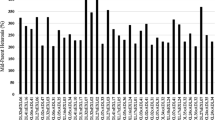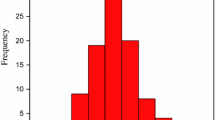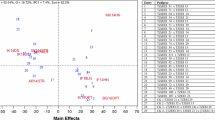Abstract
Hybrid breeding program in maize is dependent on the availability of heterotic inbred lines for full exploitation of heterosis. Identification of heterotic patterns among inbred lines is prerequisite for obtaining high yielding superior hybrids. A total of 156 inbred lines were evaluated thoroughly, out of which, a set of 25 promising parental inbred lines, derived from different heterotic pools, semi exotic and indigenous lines, were evaluated at Ludhiana for two years. Based on their reproductive synchronization and pre-determined heterotic grouping, a total of 25 hybrids have been developed. Hybrids thus developed, were evaluated for eight yield related traits for two years at two locations (Ludhiana and Gurdaspur). Highly significant differences have been observed among the inbred lines for almost all of the traits. Likewise, high significant differences have also been observed in hybrids for both years at both locations. Yield was exhibiting significant but negative correlation with days to 50% pollen and silking for both years in inbreds. Principal component analysis also revealed that days to 50% pollen and silking, anthesis-silking interval and days to 75% brown husk were negatively correlated with yield for both years in inbreds. Both association studies and principal component analysis showed no significant association with yield in hybrids for both years at both locations. On the basis of heterotic patterns of promising inbred lines, a total of seven superior hybrids were identified having high yield constantly for both years at both locations. These promising inbred lines could be used for developing source populations for generating new inbred lines in maize and the superior hybrids could be used for further testing and promotion for adoption and commercialization in sub-tropical climate.
Similar content being viewed by others
References
Amy EL, Pritts MP (1991) Application of principal component analysis to horticultural research. Hortic Sci 26(4):334–338
Anonymous (2020) Food and Agricultural Organization year book of the United Nations Rome, Italy. https://www.fao.org/3/cc2211en/cc2211en.pdf
Berzy T, Zaborszky S, Marton LC, Spitko T, Pinter J, Tothne Zsubori Z, Szoke C (2020) Effect of seed deterioration, seed dressing agents and seed vigours parameters in maize (Zea mays L) hybrids. Int J Agric Environ Bioresearch 5(2):72–81
Clifford HT, Stephenson W (1975) An introduction to numerical classification. Academic Press, New York
Comertpay G, Baloch FS, Kilian B et al 2012 Diversity Assessment of Turkish Maize Landraces based on fluorescent labelled SSR markers. Plant Mol Biol Rep 30, 261–274
Comstock RE, Moll RH (1963) Genotype x environments interaction. Pp. 164–196 In W.D. Hanson and H.F. Robinson (ed.) statistical Genetics and Plant Breed. NAS-NRC Publ. 082. Washington, D.C
Hallauer AR, Miranda JB (1981) Quantitative genetics in maize breeding. Iowa State University Press, Ames, IOWA, USA, p 512
Hartings H, Berardo N, Mazzinelli GF, Valoti P, Verderio A, Motto M (2008) Assessment of genetic diversity and relationship among maize (Zea mays L.) Italian landraces by morphological traits and AFLP profiling. Theor Appl Genet 117:831–842
Hochholdinger F, Marcon C, Baldauf JA, Yu P, Frey FP (2018) Proteomics of Maize Root Development. Front Plant Sci 9, 143. https://doi.org/10.3389/fpls.2018.00143
Hussain N, Khan MY, Baloch MS (2011) Screening of maize varieties for grain yield at Dera Ismail Khan. J Anim Plant Sci 21(3):626–628
Iqbal J, Shinwari ZK and Rabbani M. A (2015) Maize (Zea mays L.) germplasm agro-morphological characterization based on descriptive, cluster and principal component analysis. Pak J Bot 47:255–264
Kahriman F, Egesel CO, Orhun GE, Alaca B, Avci F (2016) Comparison of graphical analyses for maize genetic experiments: application of biplots and polar plot to line × tester design. Chil J Agric Res 76:285–293
Maji AT, Shaibu AA (2012) Application of principal component analysis for rice germplasm and evaluation. J Plant Breed Crop Sci 4(6):87–93
Murdia LK, Wadhwani R, Wadhawan N, Bajpai P, Shekhawat S (2016) Maize utilization in India: an overview. Am J Food Nutr 4(6), 169–176
Omar S, Tarnawa Á, Kende Z et al (2022) Germination characteristics of different maize inbred hybrids and their parental lines. Cereal Res Commun. https://doi.org/10.1007/s42976-022-00250-9
Orhun GE (2020) Investigation of agronomic and kernel quality traits of registered maize varieties using principal component biplot analysis. Maydica 65(2):1–7
Piperno DR, Flannery KV (2001) The earliest archaeological maize (Zea mays L.) from Highland Mexico: New accelerator mass spectrometry dates and their implications. Proc Natl Acad Sci USA 98(4):2101–2103
San Vicente FM, Hallauer AR (1993) Mass selection for adaptation in Antigua maize (Zea mays L.) composite. J Iowa Acad Sci 100:9–12
Sarkar A, Sandhu S, Pal L, Kushwah A, Kumar M (2022) Productivity-based assessment of tolerance to high plant density stress in tropical maize (Zea mays L.) inbred lines and their single cross hybrids. Indian J Genet Plant Breed 82(02):153–160
Sharma L, Prasanna BM, Ramesh B (2010) Analysis of phenotypic and microsattelite-based diversity of maize landraces in India, especially from the North East Himalayan region. Genetica. https://doi.org/10.1007/s10709-010-9436-1
Shiferaw B, Prasanna BM, Hellin J, Banziger M (2011) Crops that feed the world, 6. Past successes and future challenges to the role played by maize in global food security. Food Secur 3:307–327
Singh C (2002) Modern techniques of raising the field crops. Oxford and IBH Publishing Co. Pvt. Ltd. Pp, New Delhi, pp 84–111
Singh RK, Chaudhary BD (1985) Analysis in Biometrical Genetics. Kalyani Publishers, New Delhi, India
Tonk FA, Ilker E, Tosun M (2011) Evaluation of genotype x environment interactions in maize hybrids usung GGE biplot analysis. Crop Breed Applied Biotechnol 11:1–9
Yousuf N, Habib M, Dar ZA, Lone AA, Gulzar S, and., Gazal A (2016) Evaluation of combining ability for yield and yield contributing traits in single cross hybrids of maize (Zea mays L.) using line × tester analysis. The Bioscan 11(2):1037–1042
Yousuf N, Dar SA, Shikari AB, Dar ZA, Lone AA, Sofi PA, Gulzar S (2021) Assessment of genetic diversity at molecular and morphological levels of temperate maize landraces collected from diverse ecological niches in Kashmir. Indian J Genet 81(4):557–565
Yucel C, Hizli H, Firincioglu HK, Cil A, Anlarsal AE (2009) Forage yield stability of common vetch (Vicia sativa L.) genotypes in the Cukurova and GAP regions of Turkey. Turk J Agric for 33(2):119–125
Acknowledgements
We acknowledge Punjab Agricultural University, Ludhiana for their financial, technical and administrative support.
Author information
Authors and Affiliations
Contributions
AK, SS, GS and AK designed and conducted the experiments. AK, NY, TG, BRK and RR performed the data analysis. AK, NY, BRK and SS prepared and edited the final manuscript.
Corresponding author
Ethics declarations
Conflict of interest
All authors declare that there are no conflicts of interest.
Additional information
Publisher’s Note
Springer Nature remains neutral with regard to jurisdictional claims in published maps and institutional affiliations.
Electronic supplementary material
Below is the link to the electronic supplementary material.
Rights and permissions
Springer Nature or its licensor (e.g. a society or other partner) holds exclusive rights to this article under a publishing agreement with the author(s) or other rightsholder(s); author self-archiving of the accepted manuscript version of this article is solely governed by the terms of such publishing agreement and applicable law.
About this article
Cite this article
Kushwah, A., Yousuf, N., Sandhu, S. et al. Heterotic analysis and yield assessment of maize (Zea mays L.) inbred lines for developing superior hybrids under sub-tropical climatic conditions. Vegetos (2024). https://doi.org/10.1007/s42535-023-00796-x
Received:
Revised:
Accepted:
Published:
DOI: https://doi.org/10.1007/s42535-023-00796-x




